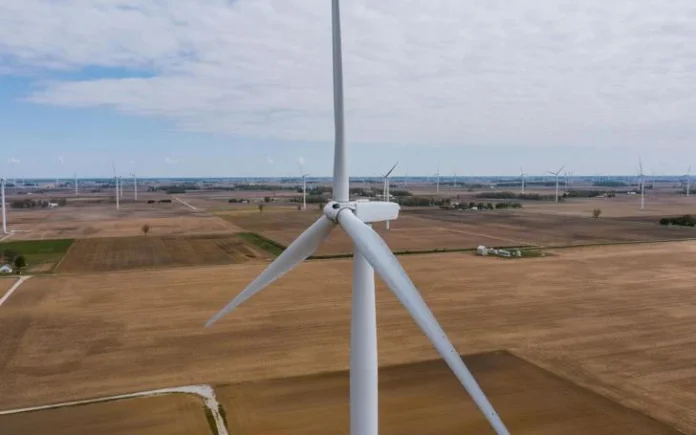-
A windmill in Tipton. How can the energy sector provide for data centers and the average Hoosier at the same time as being environmentally sound and safe?
This was a question during the recent Economic Club of Indiana’s 2025 economic luncheon. Hosted by Lisa Harris, CEO of Eskenazi Health and president of the Economic Club, John R. Bear, president and CEO of MISO, was the guest speaker. MISO is the electric grid operator for the central United States, an “air traffic controller” through which utilities can buy and sell energy and manage new energy sources. It does this for the Midwest—including Indiana.
“The pace of change is outstripping our processes. We have got to speed things up from a regulatory standpoint,” Bear said.
MISO is working to integrate more renewable energy resources into the electric grid “to keep costs down and keep reliability high.”
Bear presented some of the challenges the electric grid is facing in a swiftly changing world including data centers, climate change, tariffs and rapid economic growth.
Regarding the Hoosier state, Bear said, “I’ve never seen more economic development opportunities in a place ever. … It’s not just corn and agriculture.”
With one in five Hoosiers working in manufacturing, how can MISO support economic growth in Indiana—especially when the electric industry itself is difficult to change?
The transition from mostly coal and natural gas energy sources to wind and solar energy combined with the energy demands of artificial intelligence and data centers are complicating the energy sector, Bear said. Climate goals and fossil fuel policies must be met at the same time as keeping up with economic growth.
“When it’s windy or sunny, we’re going to deliver the wind and the sun, which is almost zero marginal cost to those that need to use it. But when it’s not—and that happens—we are going to make sure we have some energy delivered to you. And that means we need to turn the gas on or turn the coal on,” Bear said.
Data centers, many proposed in Indiana, are going to be massive consumers of energy. Constructing them will provide jobs but only on the short-term end—making them somewhat controversial. Yet businesses are finding value in data centers’ capabilities when it comes to analytics, computer powers and general computations.
“This growth is 24 by seven, 365 energy,” Bear said, “These data centers are the size of Indianapolis.”
MISO is also taking climate changes taken into consideration, he said. The energy sector has noticed relatively stable, mild temperatures across the central United States, but major winter storms are becoming more severe and more frequent in between.
“These hundred-year storms that used to happen every hundred years are happening every 18 months,” Bear said.
Energy needs to be reliable no matter the weather and available in full to both massive data centers and the average person’s home.
The energy sector must work with local utilities and municipalities to meet the varying climate goals across the United States and incorporate this into MISO’s processes, Bear said. MISO is enacting market strategies and designs to cope with this and planning processes and working directly with local utilities to tie in varying energy sources.
“They don’t have to be either or they just need to be melded together into the best solution for all so that we can make sure that we are keeping the lights on and do it really efficiently,” Bear said.
Tariffs are expected to affect MISO with an increased cost for energy supplies. Solar panels and the majority of wind turbines and wind power infrastructure are made overseas.
Renewable energy also makes electric sources more dispersed. Bear mentioned cybersecurity across the electric grid as a concern. MISO will need to work to identify threats across all energy platforms and input systems to do so.
During a question and answer session, a member of the audience asked about small modular nuclear reactors (SMRs). Bear said that the technology is likely 10-15 years away.
“I think it’s going to play a big role,” Bear said in regards to the future of SMRs. But it’s uncertain and not quite incorporated into MISO’s plans.
Bear does hope that SMRs will become viable and commercial so that they can serve as a backup if wind or solar energy is not viable.
Changing the electric grid is a difficult process, but Bear made it clear, especially in the case of Indiana: MISO has to keep up.
Olivia O’Neal is a reporter for TheStatehouseFile.com, a news site powered by Franklin College journalism students.





